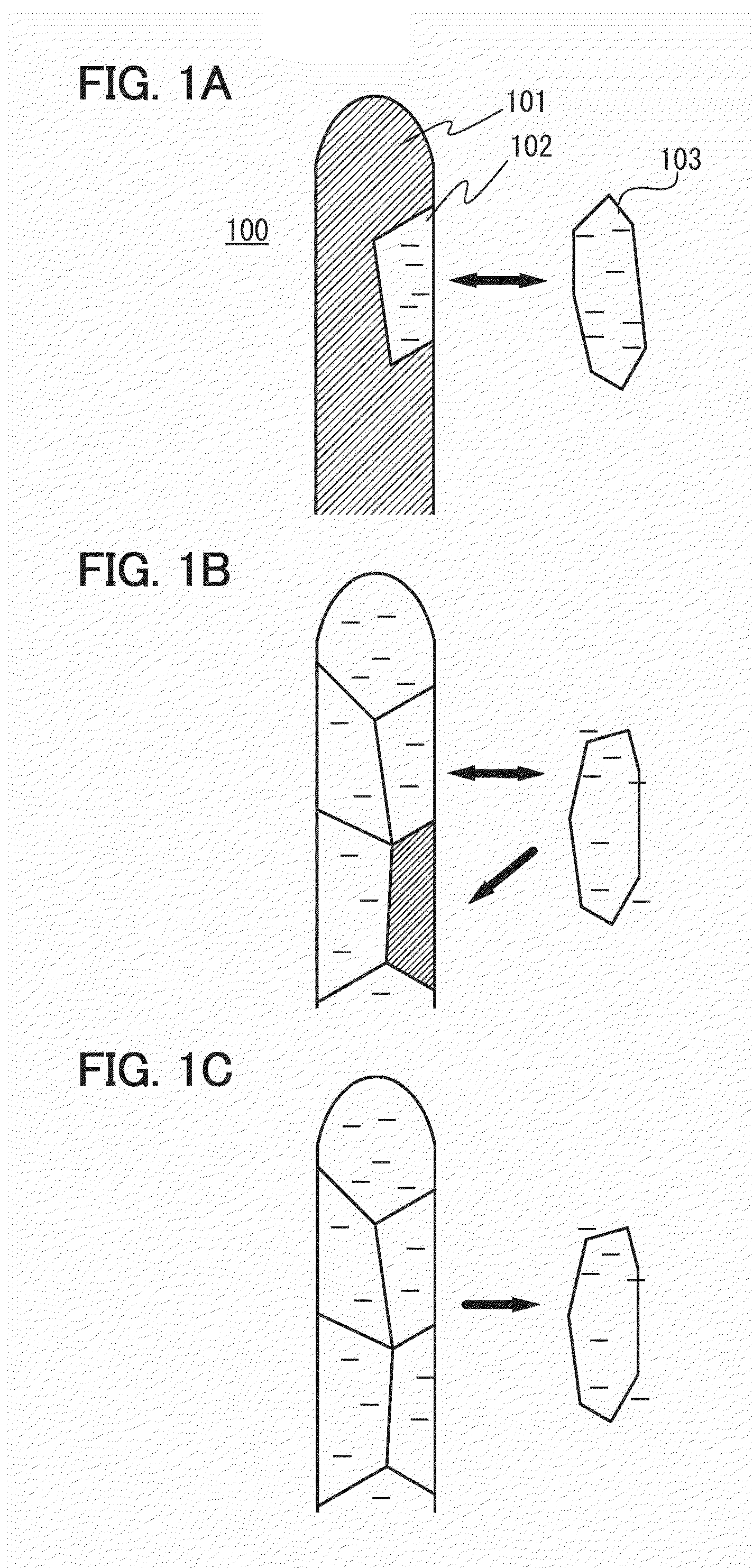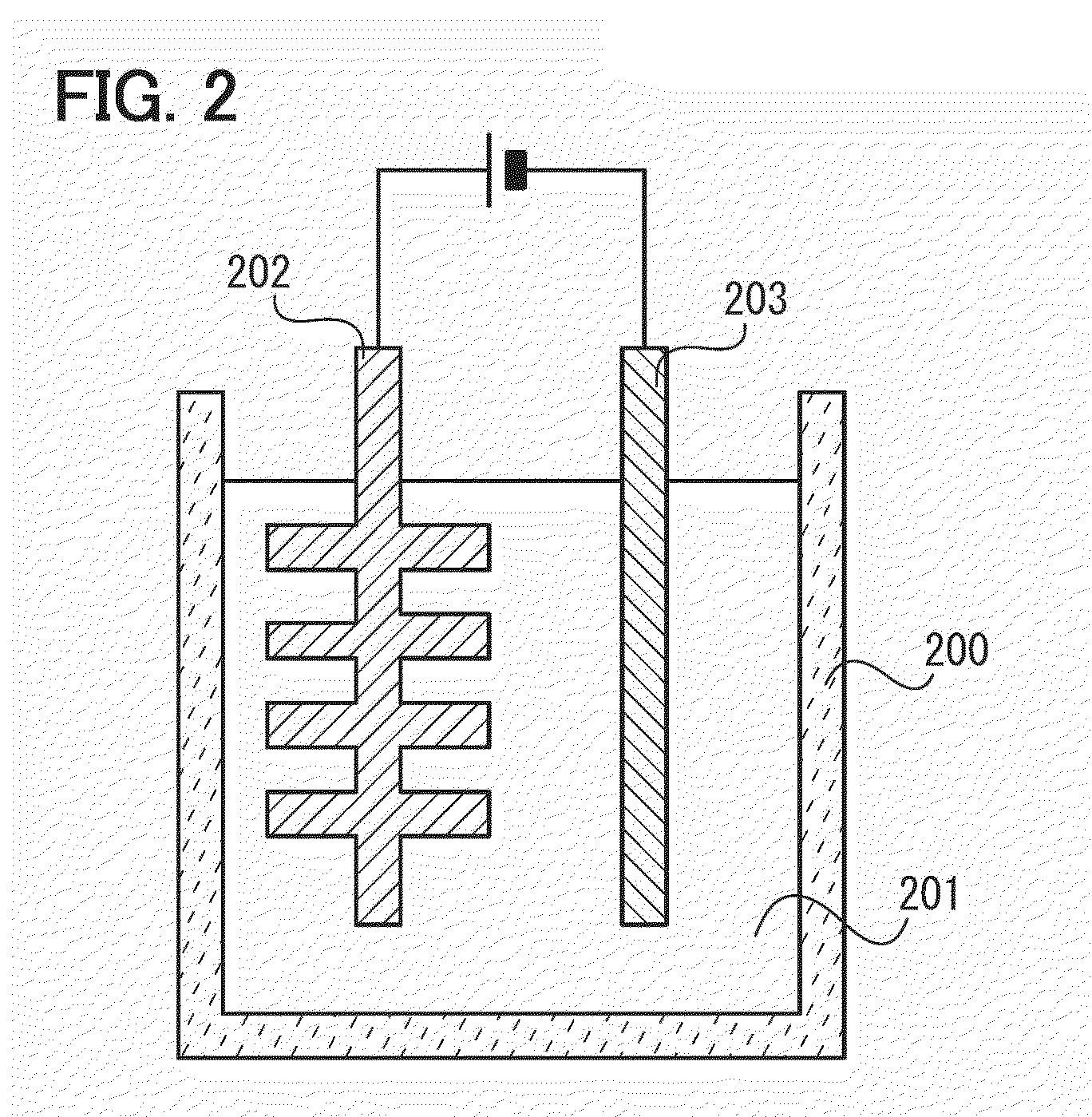Method for manufacturing graphene-coated object, negative electrode of secondary battery including graphene-coated object, and secondary battery including the negative electrode
a technology of graphene coating and secondary battery, which is applied in the direction of secondary cells, isotope separation, electrolysis, etc., can solve the problems of difficult to form graphene on an object having an uneven surface or complex surface, difficult to sufficiently form graphene on a three-dimensional surface, and difficult to crush. , to achieve the effect of sufficient flexibility of graphene, short diffusion path and preventing crushing
- Summary
- Abstract
- Description
- Claims
- Application Information
AI Technical Summary
Benefits of technology
Problems solved by technology
Method used
Image
Examples
embodiment 1
[0055]In this embodiment, a method for forming graphene on a surface of an object will be described. Graphene oxide is obtained in such a manner that graphite is oxidized to form graphite oxide and the graphite oxide is subjected to ultrasonic vibrations. For the details, refer to Patent Document 3. Alternatively, commercially available graphene oxide may be used.
[0056]Graphene oxide is dispersed in a solvent such as water, chloroform, N,N-dimethylformamide (DMF), or N-methylpyrrolidone (NMP). The solvent is preferably a polar solvent. Graphene oxide may have a concentration of 0.1 g to 10 g per liter.
[0057]FIG. 2 illustrates an apparatus used in this embodiment. A solution 201, in which graphene oxide is dispersed, is put in a container 200, and an object 202, on which graphene is to be deposited, is put therein and is used as an anode. In addition, a conductor 203 serving as a cathode is put in the solution, and electrodeposition using electrophoresis / electrophretic deposition is ...
embodiment 2
[0061]In this embodiment, an electrode including a film-like carbon-based material will be described.
[0062]As illustrated in FIG. 11, an electrode includes a current collector 1100 and a film-like carbon-like material 1102. The film-like carbon-based material 1102 may be provided over the current collector 1100 and is preferably supported so as to have a large surface area. For example, the film-like carbon-based material 1102 is supported by a plurality of projections 1101 (respectively referred to as 1101a to 1101e) on the current collector 1100. In other words, the film-like carbon-based material 1102 can be provided over the plurality of projections 1101.
[0063]The film-like carbon-based material 1102 includes 1 sheet or more and 1000 sheets or less, preferably 100 sheets or more and 300 sheets or less of graphene 1104. The graphene net is different from graphite in any of the following.
[0064]Van der Waals force forms a bond in the stacking direction (z-axis direction).
[0065]The ...
embodiment 3
[0084]In this embodiment, a structure where a carbon-based material is provided around the plurality of projections 1101 will be described.
[0085]As illustrated in FIG. 12, a carbon-based material 1103 is provided to coat the plurality of projections 1101. The carbon-based material 1103 includes 1 sheet or more and 1000 sheets or less, preferably 100 sheets or more and 300 sheets or less of the graphene 1104. When two to three sheets of graphene are stacked, the thickness of the carbon-based material is 1 nm to 2 nm. The film-like carbon-based material may be either amorphous or crystalline.
[0086]Embodiment 2 can be referred to for the structure of the other components, and the film-like carbon-based material 1102 can be provided.
[0087]The carbon-based material has conductivity. Therefore, it can be used as a conductive additive in a negative electrode. It is advantageous to provide the film-like carbon-based material 1102 described in Embodiment 2 along with the carbon-based materia...
PUM
| Property | Measurement | Unit |
|---|---|---|
| size | aaaaa | aaaaa |
| thickness | aaaaa | aaaaa |
| concentration | aaaaa | aaaaa |
Abstract
Description
Claims
Application Information
 Login to View More
Login to View More - R&D
- Intellectual Property
- Life Sciences
- Materials
- Tech Scout
- Unparalleled Data Quality
- Higher Quality Content
- 60% Fewer Hallucinations
Browse by: Latest US Patents, China's latest patents, Technical Efficacy Thesaurus, Application Domain, Technology Topic, Popular Technical Reports.
© 2025 PatSnap. All rights reserved.Legal|Privacy policy|Modern Slavery Act Transparency Statement|Sitemap|About US| Contact US: help@patsnap.com



